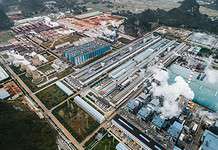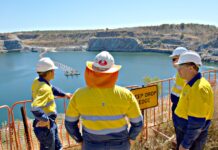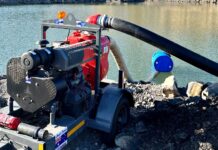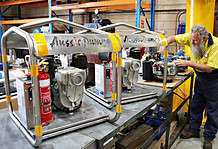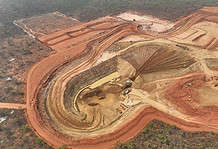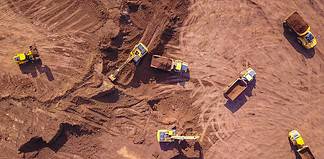A new copper mine and key enabler projects are edging closer to construction as high commodity prices drive investment in Queensland’s North West Minerals Province.
Grand Central Industries’ government-supported Inland Port Project is rapidly approaching financial close and is forecast to commence construction in Q4 2021.
The critical 333ha project will significantly debottleneck about $13b of pre-existing Queensland government-owned rail and port infrastructure—the Mt Isa Railway and Port of Townsville.
Located 7km east of Cloncurry, the project is expected to have a material economic, commercial and environmental impact to the collective benefit of all stakeholders across the supply chain.
Grand Central Industries CEO Josip Obajdin said the project provided for an essential, catalytic platform to enable the region’s further economic development and “maximise its ever-growing importance to global markets as a key supplier of future-facing commodities’’.
‘’These commodities are fueling the rise of the renewables industry and the electric vehicle market, which in turn will create a long run, positive economic ripple effect across the entire northwest supply chain and stakeholders alike in the private and public sectors,” he said.
The Inland Port project (Cloncurry Intermodal Terminal) was highlighted as an important ‘’shovel ready infrastructure project’’ in RDA’s Townsville and North West Queensland Economic Outlook report in February.
Other ‘’regional catalyst developments’’ highlighted in the report include the $1.5b CopperString 2.0 transmission line.
RDA TNWQ CEO Glenys Schuntner said the organisation welcomes investment into infrastructure that will help drive new jobs, not only through construction but importantly through productivity improvements and the ability to support other new projects going ahead.
‘’The North West Minerals Province (NWMP) is one of the most valuable and productive mining regions in the world and new freight infrastructure such as the Cloncurry intermodal terminal will support the mining sector’s future growth well into the future,” Ms Schuntner said.
CopperString 2.0 is a high-voltage transmission line that will connect the north west to the national electricity grid.
CuString managing director Joseph O’Brien said they were working towards a final investment decision by the end of 2021 after CIMIC Group’s UGL and CPB contractors signed early stage contracts to build the project.
‘’We signed an implementation agreement with the Queensland Government in October and we are working through the process to finalise approvals and regulatory arrangements,’’ he said.
‘’We have also received a $11m grant agreement from the Commonwealth and the funded development work is underway.
‘’From a mining point of view, there has certainly been a large increase in the number of development projects in the north west across traditional commodities like copper and zinc but also for metals like vanadium who have wanted to engage us to incorporate access to the national electricity market into their feasibility studies.
‘’There has been a big burst of activity, which is not surprising given where copper prices are.
‘’The NWMP – a globally significant basin – remains hamstrung by incredibly high electricity prices and shortages of firm supply creating a significant barrier to new investment even in the face of such a robust commodity outlook.’’
The NWMP, centred around Cloncurry and Mt Isa, is one of the world’s greatest mining regions and holds about 75% of Queensland’s base metal mineral endowment including copper, lead, zinc and silver as well as major phosphate deposits.
The province is ushering in a new era of mining being driven by the quest for ‘’new economy’’ minerals, including cobalt, rare-earth metals and copper for new technologies such as electric vehicles, renewable energy products, computers, smart phones and products for the medical, science, defence and space-related industries.
The copper price has doubled since the start of the pandemic, improving the economics of existing and future projects in the region.
Copper Mountain Mining Corporation (CMMC) is moving the Eva Copper project towards construction.
CMMC’s Executive Vice President of Strategy and Corporate Development, Letitia Wong, said the development plan is to complete project financing in early fourth quarter of 2021, while advancing detailed engineering to complete a final construction estimate.
‘’We have engaged Endeavour Financial to advise and assist in completing a project financing package,’’ she said.
‘’We expect to make a construction decision on Eva by year end and we are currently advancing the project with existing current cash flow.
‘’We have also commenced our 2021 exploration program on Eva and our surrounding land package.’’
The project is forecasted to product 1.5b lbs—or about 6.8mt—over the 15-year mine life.
CMMC are “avid” supporters of CopperString.
Technological advances in battery storage is driving a boom in vanadium exploration in the region, with Multicom Resources progressing its Saint Elmo project after gaining federal government approval.
Multicom CEO Shaun McCarthy said the NWMP is a world-renowned mineral-rich region in which there has been more recent focus towards extracting ‘’the new generation of critical minerals for their intended use in clean energy and new technologies’’.
‘’The project proposes to take advantage of the increasing supply gap associated with high-strength steel production, the growth market of vanadium batteries and the emergence of vanadium-based compounds as a revolutionary metal in new technologies,’’ he said.
Cloncurry Mayor Greg Campbell said high commodity prices and government grants was driving new investment in the region as well as exploration by some of the majors including BHP, Rio Tinto and Anglo American.
He supported CopperString 2.0, saying it would generate jobs in the region and lower the price of electricity for mine sites by at least 30%, potentially paving the way for new mines south of Cloncurry.
‘’Reducing the mines’ fixed costs will make them more profitable which allows them to operate for longer to give more job security to our people,’’ Mr Campbell said.
He said the Inland Port ‘’makes perfect sense’’ and the project would provide land for miners to stockpile their product before it is transported to domestic and international markets.
Mr Campbell said it was important to ensure a reliable water source and reduce green and red tape around access to water for mines south of Cloncurry to ensure continued prosperity in the region.
The shire has drawn up plans for the Cave Hill Dam project, a significant water storage facility on the Cloncurry River that would increase the combined water delivery ability in the region by more than 60%.
The project was originally geared at the agriculture sector but its viability would be improved if mining companies were able to access it, Mr Campbell said.
‘’The Federal Government funded the business case so it is investment-ready and final design-ready,” he said.
‘’Now we just need to shore up who the potential users would be and once that is done, the pathway becomes more clear on when and how to construct it.
‘’At the moment, there is at least two or three entities a mine has to deal with to get water and so one solution would be a one-stop north west water board where that entity controls all the bulk water in the region.
‘’If it was led locally, it could pull levers to encourage investment rather than access to water being an impediment to investment.’’
Mr Campbell said the mines had worked with Cloncurry Shire to keep the region’s mining camps and communities COVID-free.
The council is still working with MMG’s Dugald River zinc mine to attract more workers to the region through new housing and an incentives package.
Mr Campbell said mining companies inject millions into the local community with Glencore’s Ernest Henry Mine donating $500,000 to the town’s $3.5m recreational facility at Florence Clark Park, which opened in October.
He said all the major players in the region were ‘’interconnected’’ with Ernest Henry supporting Mt Isa Mines, which feeds into Incitec Pivot’s Phosphate Hill plant, which is the Port of Townsville’s biggest customer.
Capricorn Copper, South 32’s Cannington Mine, New Century Resources’ Century mine and Round Oak Minerals’ operations are the other major mines currently operating in the NWMP.




